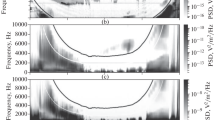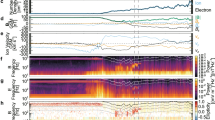Abstract
The PWI/WFC data onboard Geotail during one burst time interval when Geotail is skimming a magnetic reconnection diffusion region in the near-Earth magnetotail is carefully analyzed. Both the whistler-mode wave and the electrostatic solitary wave are found within the region with density depletion on the boundary layer near the magnetic reconnection X-line. The whistler-mode wave is electromagnetic whistler wave propagating quasi-parallel to the ambient field with a small angle between the wave vector and the ambient magnetic field. The whistler-mode wave associated with ESWs suggests that enhanced electromagnetic whistler-mode fluctuations can also be generated after the decay of the ESWs, which is different from the 2-D PIC simulation results.
Similar content being viewed by others
References
Zhang Y, Matsumoto H, Kojima H. Bursts of whistler mode waves in the upstream of the bow shock: Geotail observations. J Geophys Res, 1998, 103: 20529–20540
Pickett J S, Menietti J D, Dowell J H, et al. Polar spacecraft observations of the turbulant outer cusp/magnetopause boundary layer of Earth. Nonlinear Proc Geophys, 1999, 6: 195–204
Maksimovic M, Harvey C C, Santolík O, et al. Polarization and propagation of lion roars in the dusk side magnetosheath. Ann Geophys, 2001, 19: 1429–1438
Lu Q, Shan L, Shen C, et al. Velocity distributions of superthermal electrons fitted with a power law function in the magnetosheath: Cluster observations. J Geophys Res, 2011, 116: A03224
Kennel C F, Petschek H E. Limit on stably trapped particle fluxes. J Geophys Res, 1966, 71: 1–28
Horne R B, Thorne R M. Relativistic electron acceleration and precipitation during resonant interactions with whistler-mode chorus. Geophys Res Lett, 2003, 30(10): 1527
Horne R B, Thorne R M, Glauert S A, et al. Timescale for radiation belt electron acceleration by whistler mode chorus waves. J Geophys Res, 2005, 110: A03225
Albert J M, Young S L. Multidimensional quasi-linear diffusion of radiation belt electrons. Geophys Res Lett, 2005, 32: L14110
Lu Q, Zhou L, Wang S. Particle-in-cell simulations of whistler waves excited by an electron distribution in space plasma. J Geophys Res, 2010a, 115: A02213
Drake J F, Biskamp D, Zeiler A. Breakup of the electron current layer during 3-D collisionless magnetic reconnection. Geophys Res Lett, 1997, 24: 2921–2924
Drake J F, Swissdak M, Cattell C, et al. Formation of electron holes and particle energization during magnetic reconnection. Science, 2003, 299: 873–877
Shay M A, Drake J F, Rogers B N, et al. The scaling of collisionless magnetic reconnection for large systems. Geophys Res Lett, 1999, 26: 2163–2166
Shay M A, Drake J F, Rogers B N, et al. Alfvenic collisionless magnetic reconnection and the Hall term. J Geophys Res, 2001, 106(43): 3759–3772
Birn J, Drake J F, Shay M A, et al. Geospace Environmental Modeling (GEM) magnetic reconnection challenge. J Geophys Res, 2001, 106(A3): 3715–3719
Birn J, Hesse M. Geospace Environment Modeling (GEM) magnetic reconnection challenge: Resistive tearing, anisotropic pressure and Hall effects. J Geophys Res, 2001, 106(A3): 3737–3750
Deng X H, Matsumoto H. Rapid magnetic reconnection in the Earth’s magnetosphere mediated by whistler waves. Nature, 2001, 410: 557–560
Rogers B N, Denton R E, Drake J F, et al. Role of dispersive waves in collisionless magnetic reconnection. Phys Rev Lett, 2001, 87: 195004
Vaivads A, Khotyaintsev Y, André M, et al. Structure of the magnetic reconnection diffusion region from four-spacecraft observations. Phys Rev Lett, 2004, 93(10): 105001
Wei X H, Cao J B, Zhou G C, et al. Cluster observations of waves in the whistler frequency range associated with magnetic reconnection in the Earth’s magnetotail. J Geophys Res, 2007, II2(A10): A10225
Matsumoto H, Kojima H, Miyatake T, et al. Electrostatic solitary waves ESW in the magnetotail: BEN waveforms observed by Geotail. Geophys Res Lett, 1994a, 21: 2915–2918
Matsumoto H, Frank L A, Omura Y, et al. Generation mechanism of ESW based on GEOTEIL plasma wave observation, plasma observation and particle simulation. Geophys Res Lett, 1999, 26(3): 421–424
Matsumoto H, Deng X H, Kojima H, et al. Observation of electrostatic solitary waves associated with reconnection on the dayside magnetopause boundary. Geophys Res Lett, 2003, 306: 1326
Omura Y, Matsumoto H, Miyake T, et al. Electron beam instabilities as generation mechanism of electrostatic solitary waves in the magnetotail. J Geophys Res, 1996, 101: 2685–2697
Kojima H, Omura Y, Matsumoto H, et al. Characteristics of electrostatic solitary waves observed in the plasma sheet boundary: Statistical analysis. Non Proc Geophys, 1999, 6: 179–186
Lu Q, Wang S, Dou X. Electrostatic waves in an electron-beam plasma system. Phys Plasmas, 2005a, 12: 072903
Lu Q M, Wang D Y, Wang S. Generation mechanism of electrostatic solitary structures in the Earth’s auroral region. J Geophys Res, 2005b, 110: A03223
Deng X H, Matsumoto H, Kojima H, et al. Geotail encounter with reconnection diffusion region in the Earth’s magnetotail: Evidence of multiple X lines collisionless reconnection? J Geophys Res, 2004, 109: A05206
Li S Y, Deng X H, Zhou M, et al. Statistical study of electrostatic solitary waves associated with reconnection: Geotail observations. J Adv Space Res, 2009a, 43(3): 394–400
Li S Y, Deng X H, Wang J F. Characteristic and role of ESW observed in the separatrix of reconnection in the magnetotail. Chin J Geophys, 2009b, 52(4): 902–910
Li S Y, Deng X H, Zhou M, et al. Cluster observation of electrostatic solitary waves around magnetic null point in thin current sheet. Chin Phys Lett, 2010, 27(1): 019401
Oppenheim M, Newman D L, Goldman M V. Evolution of electron phase-space holes in a 2D magnetized plasma. Phys Rev Lett, 1999, 83(12): 2344–2347
Lu Q M, Huang C. Two-dimensional electron phase-space holes in space plasmas (in Chinese). J Univ Sci Technol China, 2007, 37(8): 879–884
Tao J B, Lu Q M, Wang S. 2D particle-in-cell simulations on electrostatic solitary waves (in Chinese). Chin J Space Sci, 2007, 27(2): 110–116
Lu Q M, Lembege B, Tao J B, et al. Perpendicular electric field in two-dimensional electron phase holes: A parameter study. J Geophys Res, 2008, 113: A11219
Wu M, Lu Q, Huang C, et al. Transverse instability and perpendicular electric field in two dimensional electron phase-space holes. J Geophys Res, 2010, 115: A10245
Li S Y, Zhang S F, Deng X H, et al. Spatial evolution of electrostatic solitary waves along plasma sheet boundary layer adjacent to the magnetic reconnection X-line. Chin Phys Lett, 2012, 29(8): 089402
Yang H A, Jin S P, Zhou G C. Density depletion and Hall effect in magnetic reconnection. J Geophys Res, 2006, 111: A11223
Lu Q, Huang C, Xie J, et al. Features of separatrix regions in magnetic reconnection: Comparison of 2-D particle-in-cell simulations and Cluster observations. J Geophys Res, 2010b, 115: A11208
Huang G L, Wang D Y, Song Q W. Whistler waves in Freja observations. J Geophys Res, 2004, 109(A2): A02307
Matsumoto H, Nagano I, Anderson R R, et al. Plasma wave observations with Geotail Spacecraft. J Geomagn Geoeletr, 1994b, 46: 59–95
Zhang Y, Matsumoto H, Kojima H. Whistler mode waves in the magnetotail. J Geophys Res, 1999, 104(A12): 28633–28644
Guo J, Lu Q M, Wang S, et al. Whistler mode wave in collisionless magnetic reconnection. Chin Phys Lett, 2004, 21(7): 1306–1309
Author information
Authors and Affiliations
Corresponding author
Rights and permissions
About this article
Cite this article
Li, S., Zhang, S., Cai, H. et al. Observation and analysis of whistler-mode wave and electrostatic solitary waves within density depletion near magnetic reconnection X-line. Sci. China Phys. Mech. Astron. 57, 652–658 (2014). https://doi.org/10.1007/s11433-013-5237-8
Received:
Accepted:
Published:
Issue Date:
DOI: https://doi.org/10.1007/s11433-013-5237-8




